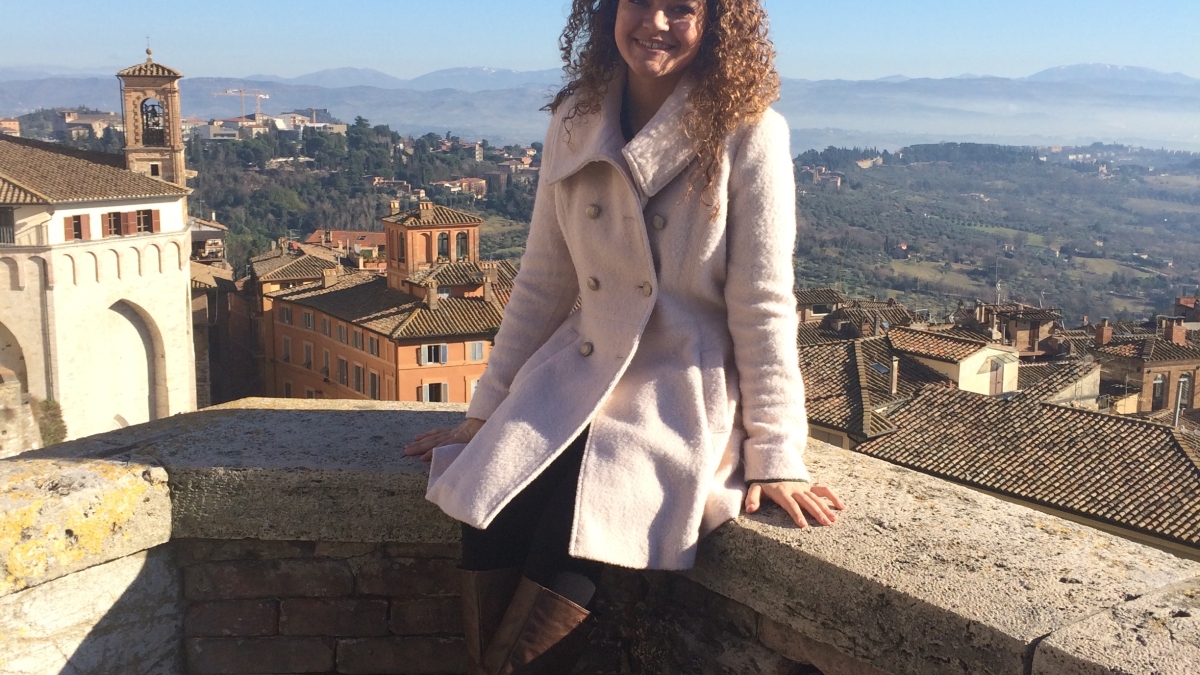Exploring intersection of food, sustainability and culture in Italy

ASU student Lynnsey Bogash spent a semester studying food and sustainability at the Umbra Institute in Perugia, Italy.
Photo courtesy Lynnsey Bogash
When ASU student Lynnsey Bogash decided to study abroad in Italy, she had her sights set on Florence or Rome.
She never imagined that she would spend a semester studying food and sustainability at the Umbra Institute in Perugia, which ended up being the perfect place for this nutrition major with a passion for food.
“Perugia is exactly what I pictured when I thought of Italy. It is a town full of winding, narrow, cobblestone streets, full of family-owned businesses, the Italian language and gelato shops,” said Bogash, who pointed out that the three universities in the center of the city gave her the opportunity to meet students from a number of countries.
For Bogash, the interdisciplinary Food & Sustainability Studies Program at Umbra combined her desire to study in Italy and her love of food. Three classes make up the bulk of Umbra’s program: History and Culture of Food in Italy, the Business and Study of Wine: Italy and Beyond, and Sustainability and Food Production in Italy.
The sustainability course focuses on the significant increase in food production over the past 50 years and the ecological and social problems it has created, as well as possible solutions. Bogash learned about the organic movement, Slow Food, innovative food technologies, and the shift toward local food – a shift happening both in America and Italy.
The Umbra Institute also requires students to take an Italian language class or a class taught in Italian. Bogash said learning the language was essential to her time in Italy.
“Very little English is spoken in Perugia, so if you don’t know the language you are kind of out of luck," she said. “I remember being in a restaurant at the beginning of the semester and I could not order my food correctly.”
During her wine studies class, Bogash and a team of classmates worked on a project to market wine from the sustainable Roccafiore Cellars to customers in the United States. She said she enjoyed this project because it was her first time giving a professional presentation.
One of the biggest differences she noticed between the U.S. and Italy is how long it takes to finish a meal. In Italy, once patrons get a table at a restaurant they technically have that table for the entire night while in the U.S. restaurants work to turn tables quickly.
“The food culture in Italy is very different from the food culture in America,” she said. “In Italy, food is really valued and the time spent eating food is really valued as well. Meals can take hours to complete because people spend a lot of time visiting with their company. Here in America, we are always rushing with our food.”
Bogash’s biggest take away has been the cultural awareness she gained studying abroad. Before living in Italy, she would be frustrated with someone if he or she could not communicate with her. Now she understands what it’s like not being able to speak the native language.
“I want to go into the medical field, and there is probably going to be a time when I have trouble communicating with other people,” she said. “After knowing how it feels to be on both sides of the communication ‘problem,’ I feel as if I have increased my cultural awareness. I’m grateful that I had this eye-opening experience before heading out into the real world.”
Linda Vaughan, director and professor in ASU’s School of Nutrition and Health Promotion in the College of Health Solutions, believes that Bogash’s experiences in Italy provide a great example of how ASU students can broaden their experiences beyond the traditional classroom.
“As a total stranger upon her arrival in Italy navigating an unfamiliar place, Lynnsey has strengthened many important skills and will be a much more generous and supportive practitioner once she starts her professional life,” Vaughan said. “Even if a student can’t afford to study abroad, volunteering or working with an immigrant population within their own hometown or community can offer many of the cultural opportunities describe by Lynnsey.”
Written by Kaly Nasiff
Media contact:
Denise Kronsteiner
denise.kronsteiner@asu.edu
(602) 496-0983